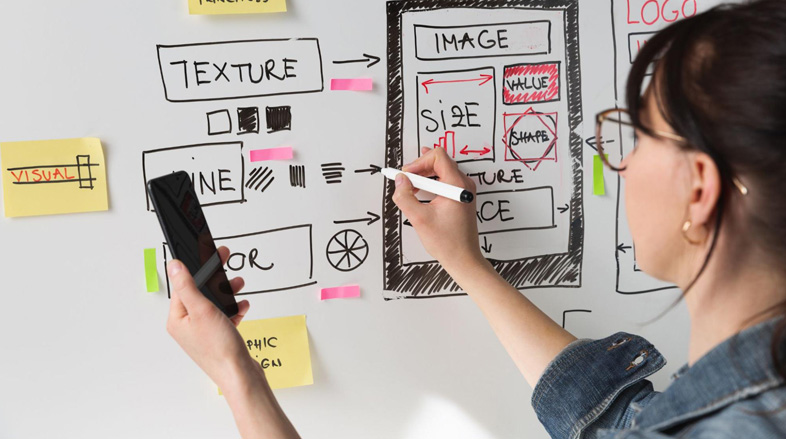Guide to Setting Up Website Email on Mobile and Computer
Follow the guide to set up your domain email on any device or OS, including both smartphones and computers, quickly and easily.

5 important tips for UX design that will make you create more creative and efficient websites in designing products
5 important points in UX design that will help you create more creative and efficient websites in designing products with UX user experiences.
As explained in previous posts about UI Design, user experience is the hallmark of product design, whether it's a website product, a mobile app, or something else.
While it should be obvious that UX is essential to product design, some UX designers have many misconceptions about it.
But the reality is that if your UX design increases clicks with your target audience, your product will thrive and grow. If it doesn't, you need to work harder.
This guide covers the basics of approaching the UX design process at a conceptual level. These tips will help you figure out how to become a better UX designer.
UX design is all about connectivity.
Likewise, interaction is one of the most important elements in app development.
But UX designers are often victims of the mindset of reinventing the wheel or trying to fix what's broken.
There's a reason why most websites and mobile apps have a similar structure: Because users are used to it.
This is the psychology of habitual habit.
Users don't always like change.
They are used to the usual way of presenting and don't like to adapt to different things.
Usually, this desire to reinvent the wheel manifests itself in unnecessary layouts, strange color schemes, placing fonts in the wrong places, and confusing navigation patterns.
The goal is to differentiate one product from the rest so that it stands out more, but instead of distinguishing, it scares the user.
That's why it's best to use tested designs across the product with minor tweaks to fit your specific goals.
This approach immediately familiarizes users with your system and allows them to use it without being bothered by unfamiliar layouts.
For example, there is no reason to move the navigation bar from the top of the screen to the bottom or change the way users interact with a mobile app.
Sticking to tested patterns will save your energy for things where design innovation is actually important, including landing pages.
Another major problem that often occurs in the UX design process is when everything is too complicated.
There are familiar patterns there (unlike when designers try to reinvent the wheel), but there are too many of these patterns and because of that, the design doesn't work.
Simplicity in design allows the user to not be confused by additional complexities when entering a page, but rather to easily separate the different sections of the page.
For this reason, it's best to keep things user-friendly. Your goal is to keep the user focused on getting what they need on your website. Don't distract them from your goal.
Another thing that is very important today in website design as well as site optimization is responsive design.
Nowadays, most users visit your site through different devices with different dimensions, so it is important that your site does not become cluttered on all devices and that the principles of responsive site design are observed so that most users have the right belief about your site in mind, and only then will they achieve their goals, otherwise they will leave the site.
How a UX designer keeps design simple in practice:
Each page has a specific purpose. For example, a checkout page only has what is needed for the checkout process.
The contact page only contains contact information and/or a form - no tips on personal grooming habits.
The purpose of each page and each component on it is immediately understandable by the user without explanation. Any additional but unnecessary information goes to the bottom of the page.
For example, have an additional list at the end of the post with the content "You may also like".

Understanding the needs and wants of your target audience may seem like a high point in UX design, but remember.
Just like anywhere else, UX designers cannot deliver the right UX design without understanding the needs and wants of their target audience.
Why is this a problem? Because of the false assumption that if you are in a market segment, you know what the audience wants and needs without studying it.
While some of your intuition may be ticked off by this, much of it will not work out.
Using these two steps, capture this vital user experience information right during the design process:
Collect feedback from your users through surveys.
See how users use your product or similar products, in person or remotely.
Here are the types of questions this information might answer for you:
Who are your users, demographically? (Example: men, women, tech savvy, tech beginners, young adults, etc.)
What are your users' needs? How can you provide a solution to their needs?
How is the relationship between their needs and your value proposition revealed in the interface design?
The answers to these questions form the foundation of a valid UX design idea.
A visually distinct landing page is one of the most important goals for UX designers.
This is a way to retain users and make the user experience engaging.
The most valuable information on the page should be the most featured.
If this is a blog post, then you need a clear headline like “Best Web Design Trends” and subheadings and subtitles that delve deeper into the topic.
Users should be aware of its location on the website or mobile app.
Navigation tools must be available.
For example, you have a website navigation panel at the top of the page where all the important sections of the website are easily accessible.
Social media sharing buttons are usually located on the left side.
On the right - place the blogroll with popular items, a tag cloud and other auxiliary elements.
The "You May Also Like" content goes at the end and is intended to encourage the user to go to other pages.
Buttons should be upright and include a clear explanation of their purpose.
The basic credentials are attractiveness, universality, readability, and functionality.
For example, a subscribe button with a field to type your email.
The search field should ideally be marked with the word "search" followed by a glass icon.
Traditionally, it is located in the upper right corner of a page.
And when it comes to colors, you should keep in mind that:
One of the most important practical aspects of user experience design is the "flow" of the user's search.
In design terms, flow is when a user moves from one section of a website or mobile app to another seamlessly in fulfilling their ultimate goal – regardless of value.
Here's why it's important: A consistent design scheme helps users get to what they want and need easily and without getting confused. So to keep things consistent, you need to think about what the user wants step by step.
For example, let's start a website flow and put ourselves in the user's shoes.
The user begins their search at an entry point – usually the homepage or a blog post.
You have to think about where that entry point leads to.
For example, it could lead to another blog post that deals with this topic or a page that offers a service or product that meets the user's needs.
Another thing to consider is dead-end pages – pages that lead nowhere else.
You should avoid such things during user searches if possible.
Everything must lead to something.
Ultimately, every website flow has an end goal – where the needs of your users and the goals of your website are met.
For example, if users are looking for valuable content and you provide valuable content, the ultimate goal is likely to be a subscription button or Patreon link.
The secret to good UX design is its effectiveness for your users and your platform.
In fact, a beautifully designed user experience steers the user towards the information or tool they need, while eliminating anything that might disrupt their journey.
Although the global goal seems understandable, achieving it can be a bit difficult.
These UX design tips will help you understand the key elements that will make your design click with your intended audience, and the interaction will be beneficial for both you and your users.
Source » Itroz Academy


Follow the guide to set up your domain email on any device or OS, including both smartphones and computers, quickly and easily.

This guide is useful for automatically forwarding your website emails set up on your domain to other email accounts, such as Gmail and others.

Step-by-step guide to install Thunderbird on macOS; download, setup, and manage multiple email accounts easily and efficiently.
Comments (0)